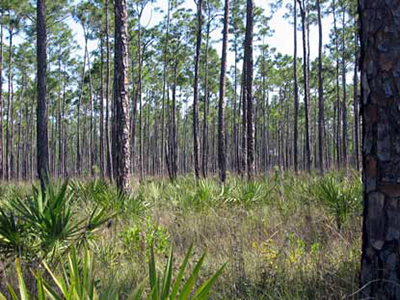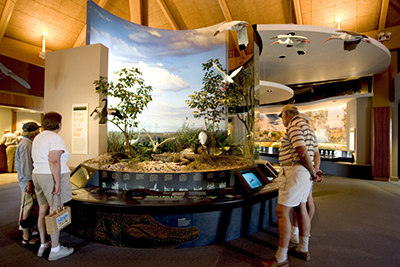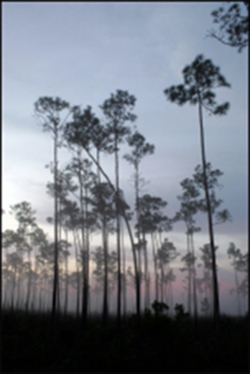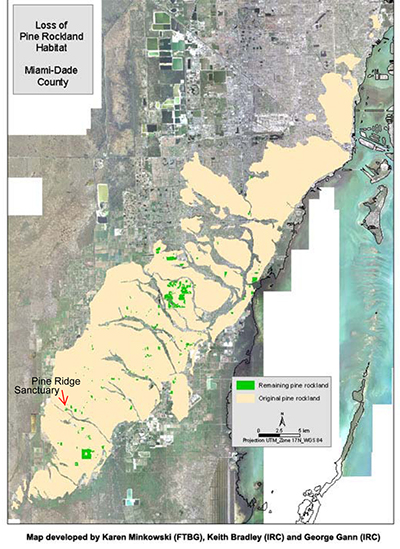
Rock Pinelands natural beauty disappearing
FLORIDA CITY, Fla. – When he was six years old, Leon Howell’s father gave him the night sky. He showed Howell how to use the family’s telescope, merging his small, childish world with the world of science. His interest piqued, Howell, now 65, never looked back. Scientific studies of all kinds quickly became part of his daily life.
For Katie Bradley, the process was delayed and more gradual. At 18, she left her home in Cape Girardeau, Mo., to study psychology and human social development at the University of Miami. She made it her personal goal to get to know the city, and the rest of South Florida as best as she possibly could in the four years she would spend there.
Enter the Everglades.
| The Pine Rocklands are home to a diverse population of both tropical and temperate plant species coexisting in one natural habitat (Photo courtesy of the National Park Service). |  |
While Howell has made the study of natural science—including everything from botany to geology—his life, Bradley has only recently developed an interest in what the natural environment has to offer.
“I first visited the Everglades ‘cause it’s one of those things, you know?” said Bradley. “You’ve got to go at least once when you live down here.”
One visit wasn’t enough. Bradley, now 20, has been back four or five times in her three years living in Miami. “Each time I come, I see something new,” she said. “This time I chose the pine rocklands because I’ve seen some of the other spots and this one seems less well-known.”
Howell, who has worked at Everglades National Park as a Natural History Interpretive Park Ranger since 2005, can confirm this. “People like to visit Shark Valley and the campgrounds. But if you drive along the main road you can get a sampling of everything.”
“I can’t pick a favorite part of the park, but this one [the pine rocklands] is up there,” said Howell. “I love the feel of this place. First off, it’s dry. And just being out here when you can hear the wind in the trees…that’s nice.” When he said this, Howell’s expression darkened almost imperceptibly. After being prompted to, he pulled out a map of the park and began to explain.
“See this big section right here?” he said while circling a significant chunk of the Florida peninsula on the map. “All this use to be pinelands. Now it’s buildings and pavement.” According to Howell, only 10 percent of the pine rocklands remain. The other 90 percent belongs to the expanding city of Miami. “It’s the most degraded habitat in South Florida. It’s considered ‘globally imperiled’.”
Nothing is being done to combat the degradation of the pine rocklands. “We just maintain what we have. We have no way of getting back what we lost. When they’re gone, they’re gone,” said Howell. “Reversal would only be possible if you knocked down all the buildings. That’s just not going to happen.”
 |
Park visitors look at an exhibit at the Coe Visitor Center at Everglades National Park near Florida City (Photo courtesy of the National Park Service). |
The growth in buildings and canals has done more than degrade the pine rocklands. It has changed nature’s ability to take care of itself. The National Park Service has been forced to implement a tactic called ‘prescribed fires’ in the pine rocklands.
Every four to seven years, specially trained staff members purposefully start fires in the pinelands to prevent them from turning into hardwood forests. The fires burn the tropical understory, which allows the temperate pines to access the sun.
“Historically the fires happened naturally, by lightning,” Howell explained. “But the roads and canals got in the way and restricted the fires. The wildlife, the plants, the whole habitat wouldn’t be here without the fires.”
Along with city expansion, environmental issues have caused changes to the pine rocklands, and the Everglades National Park as a whole.
“There is some indication that with climate change there may be less rainfall, which would mean fewer prairies and more pine communities,” said Howell. “So, I guess that’s good news for the pinelands, but not the other areas.” The only other change Howell mentioned was that there would be less temperate species and more tropical ones. “I’m not one of the ‘doomsayers’,” said Howell. “But there will be effects. There already have been. Especially on the shorelines.”
| The sun rises over the Pine Rocklands, bringing on a new day of activities for visitors to the Everglades (Photo courtesy of the Natiional Park Service). |  |
For now, though, Howell seems unconcerned. The dry season—with its lower temperatures, absence of bugs and mosquitoes, and abundance of both plant- and wildlife — and the wet season — with its lush, green vegetation, and acres of wild flowers—will continue to draw tourists from all over the world to the pine rocklands.
The most popular time to visit the pine rocklands is from mid-December to March, which falls during the dry season. Over the course of these several months, Howell’s duties as park ranger will consist of less time spent inside the visitor center, and more time leading hikes and programs for both children and adults.
“That’s the best part of my job,” said Howell. “I’m a science and nature nut. They pay me to do something I love. I get to talk about what I like, and to share what I know with people from all over the world who are interested in what I have to say. It doesn’t get much better than that.”
If You Go
Ernest Coe Visitor Center
- 40001 State Road 9336, Homestead, Fla. 33034
- Hours of Operation: 9 a.m. – 5 p.m. (hours subject to change)
- Phone: 305-242-7700
- Website: http://www.nps.gov/ever/planyourvisit/coedirections.htm
Gulf Coast Visitor Center
- 815 Oyster Bar Lane, Everglades City, Fla. 34139
- Hours of Operation: 9 a.m. to 4 p.m. mid-April through mid-Nov.
- 8 a.m. to 4:30 p.m. mid-Nov. through mid-April (hours subject to change.)
- Phone: 239-695-3311
- Website: http://www.nps.gov/ever/planyourvisit/gcdirections.htm
Chekika Day Use Area
- 24200 SW 160th Street. Miami, Fla. 33187
- Hours of Operation: Open: Dec. 1 – April 30
- Closed: May 1 – Nov. 30 (hours subject to change.)
- Phone: 305-242-7700
- Website: http://www.nps.gov/ever/planyourvisit/chekika.htm
Entrances to Everglades National Park are open 365 days a year, 24 hours a day. Some entrances are closed in the evening or seasonally.
For more information on booking reservations for programs and activities offered at the Everglades National Park visit http://www.nps.gov/ever/forkids/pine-rocklands.htm
 |
According to Park Ranger Leon Howell, just 10 percent of the Pine Rocklands habitat remains in South Florida following decades of urban development. This map shows the degradation (Map courtesy of Karen Minkowski, Keith Bradley and George Gann, Institute for Regional Conservation). |

Comments are Closed